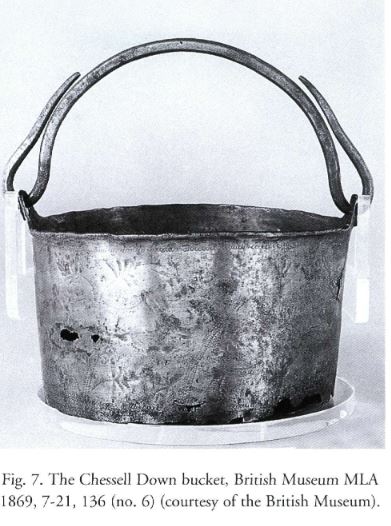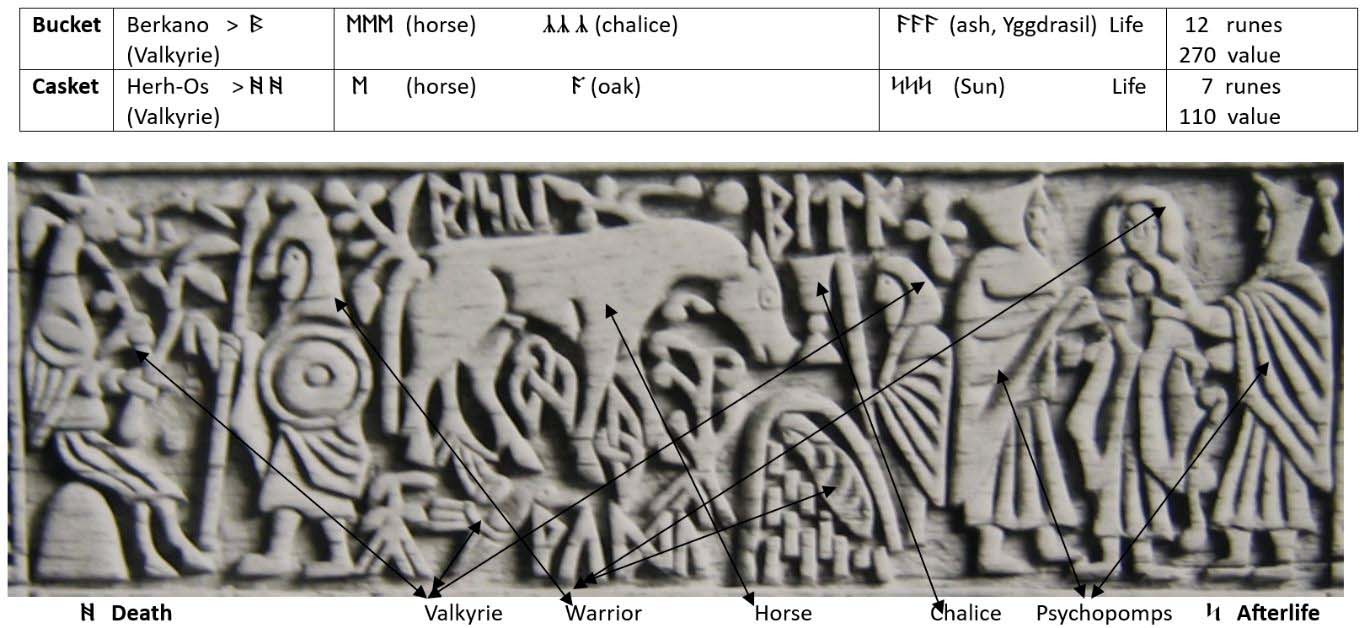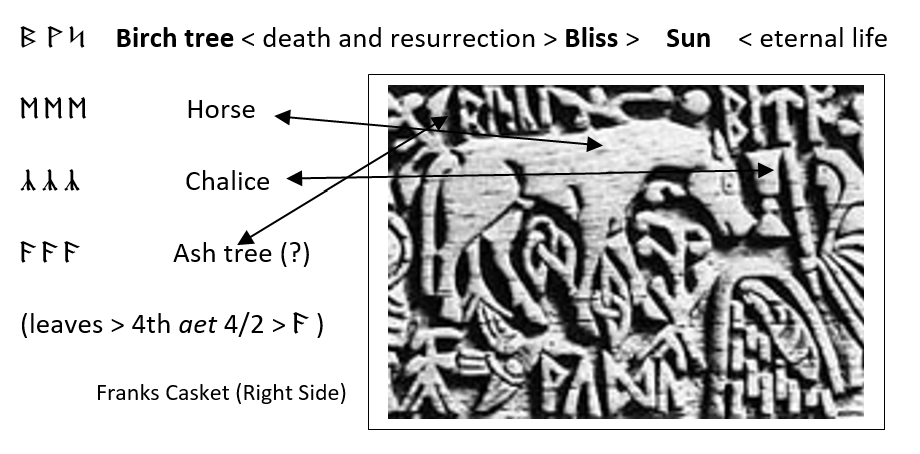|
The Chessel Down Bucket:
A Runic Way of How to Kick It.

Grave goods, as we know them from Sutton Hoo, among others, should accompany the dead hero into the afterlife, serve him and presumably mark his status. But in what way should a "bucket" like the one found at Chessell Down be helpful? According to the British Museum's description, it is “a brass pail, cylindrical with a long-looped faceted handle; punched frieze of deer-hunt among trees; dog; leopard; runic inscription.”1
Actually, this Byzantine work dates from the 6th century and was later carved with runes, with "Old English" as a language information with a question mark, because it is a cryptic series of 12 runes2:
           
BSW EEE KKK ÆÆÆ
To find an access here, we analyse a scene of death and resurrection, as we know it from the Franks Casket (Auzon Runic Casket)3. So how does this path lead from the battlefield on earth to Valhalla, Odin/Woden’s kingdom in the top of the ash tree, Yggdrasil? The image on the casket provides a perfect representation of what happened, as described by the surrounding runic text:
Text (as divided on the edges):
Top: herh os sitæþ on hærmbergæ agl(ac)
Right: drigiþ swa
Bottom: hir i erta e gisgraf særden sorgæ a
Left: nd sefa tornæ
Alliteration: hh - ea - sss
Translation (divided into long lines):
The forest deity sits on the mountain of calamity
She causes them misfortune as Erta has instructed her to do
They cause sorrow and grief of heart
Picture (Franks Casket, Right side):

Left: The hero meets his Valkyrie - the battle-helping Fylgja who guided him through life - now in her terrifying appearance, Herh Os ( rune h), the forest deity.4
By the snake around her mouth Odin/Woden’s spell may be symbolized. The twig of fate (risci) in her hand becomes "wood" (wudu, metaphor for "spear") and thus a deadly weapon (bita). Paralyzed by the sight of the terrifying figure, our warrior succumbs to the enemy; but in the end it is the chooser of the dead, the Valkyrie, who takes him home. rune h), the forest deity.4
By the snake around her mouth Odin/Woden’s spell may be symbolized. The twig of fate (risci) in her hand becomes "wood" (wudu, metaphor for "spear") and thus a deadly weapon (bita). Paralyzed by the sight of the terrifying figure, our warrior succumbs to the enemy; but in the end it is the chooser of the dead, the Valkyrie, who takes him home.
Runes: The H rune  (H = hagal, hail) augurs "disaster". With it the scene is aptly commented. (H = hagal, hail) augurs "disaster". With it the scene is aptly commented.
Centre: The incident may take place in the forest (a sacred grove of oaks, perhaps). The Valkyrie flies in her bird shape to that place, in order to awaken (now in her human shape) the fallen (here in his grave) by a drink, from her chalice. A horse, which is marked by the Woden's Knot5 ("triskele") as Sleipnir, the god's horse, will carry the revived hero to Valhalla.
Runes:  (A =ac, oak) and (A =ac, oak) and  (E = eh, horse). Also these rune names correspond to the picture, which shows Woden’s steed as well as some leaves and roots of a tree, an oak, perhaps. Beyond that the runic titulus (E = eh, horse). Also these rune names correspond to the picture, which shows Woden’s steed as well as some leaves and roots of a tree, an oak, perhaps. Beyond that the runic titulus     (wudu) is found, with which the forest (or, as a metaphor, the spear shaft) may be meant. Roots and leaves of the plants, read as twig runes, comment on the scene. (wudu) is found, with which the forest (or, as a metaphor, the spear shaft) may be meant. Roots and leaves of the plants, read as twig runes, comment on the scene.
 Right: Here two soul guides (Psychopomps) seem to seize the fallen in order to guide him to his final destination. However, this constellation - except perhaps on the Sutton Hoo purse - is not known.
Right: Here two soul guides (Psychopomps) seem to seize the fallen in order to guide him to his final destination. However, this constellation - except perhaps on the Sutton Hoo purse - is not known.
Runes:    (S = sigel, sun). The sun or its light is a symbol of resurrection and life. Again, the name of the rune and the message of the picture correspond. (S = sigel, sun). The sun or its light is a symbol of resurrection and life. Again, the name of the rune and the message of the picture correspond.
Runic value
The value of each rune is determined by its position in the rune row. The 7 alliterating runes are H (9) / A (25) / E (13) / S (16). They (  = 18 / = 18 /   = 44 / = 44 /    = 48) produce the value 110 (10 x 11). = 48) produce the value 110 (10 x 11).
The 11 and especially its multiple plays a special, probably magical role on the box. Thus, on the three panels dedicated to life, the 3 incantations of 9 runes each produce the value 33, while on this panel dedicated to death and resurrection, the formula drigiþ swa with its 9 runes produces the value 110.
 The pictorial formula, according to which the fallen warrior is resurrected by the Valkyrie through a potion in order to ride to Valhalla on Odin/Woden's horse, is also found on the Gothic picture stone of Lärbro, Tjängvide and others.
The pictorial formula, according to which the fallen warrior is resurrected by the Valkyrie through a potion in order to ride to Valhalla on Odin/Woden's horse, is also found on the Gothic picture stone of Lärbro, Tjängvide and others.
If the sequence of runes on the Chessell Down bucket does not make any literal sense, the names of the runes6 as well as their number and rune value may be helpful. To begin with the latter, the number of runes, 12, relates to the months of the year, as the rune  (Y), ger, year, a indicates. Thus it is a meaningful number. Their total value is 270, which is 3 x 3 x 3 x 10. 27 would be powerful in itself, but here it is amplified by 10 times, whereby 10 makes it infinite. (Y), ger, year, a indicates. Thus it is a meaningful number. Their total value is 270, which is 3 x 3 x 3 x 10. 27 would be powerful in itself, but here it is amplified by 10 times, whereby 10 makes it infinite.
            Since the first 3 runes (BSW) are followed by 3 groups of 3 runes of the same kind (E E K K Æ Æ Æ), we can regard b s w as a kind of invocation, especially as Since the first 3 runes (BSW) are followed by 3 groups of 3 runes of the same kind (E E K K Æ Æ Æ), we can regard b s w as a kind of invocation, especially as  (beorc) stands for the birch tree and could thus point to a deity or Valkyrie “Berkano” who rules over life, death and rebirth7. This particular name may be picked because of its initial (beorc) stands for the birch tree and could thus point to a deity or Valkyrie “Berkano” who rules over life, death and rebirth7. This particular name may be picked because of its initial  in order to achieve the magic value 270. in order to achieve the magic value 270.
With regard to the cryptic runic sequence on the Chessell Down Bucket, this means:
 beorc (Berkano) corresponds in her nature to the Valkyrie, in this case the forest deity Herh-os. Both initially bring death in battle, precondition for Valhalla. (comp. Left scene, rune h = misfortune). beorc (Berkano) corresponds in her nature to the Valkyrie, in this case the forest deity Herh-os. Both initially bring death in battle, precondition for Valhalla. (comp. Left scene, rune h = misfortune).
 wyn (joy) here describes the bliss of the resurrection through the potion from the cup and Woden’s horse for the ride to Valhalla. (comp. FC right side, centre, runes wyn (joy) here describes the bliss of the resurrection through the potion from the cup and Woden’s horse for the ride to Valhalla. (comp. FC right side, centre, runes  = oak and = oak and  = horse). = horse).
 sigel (sun) finally stands for the afterlife among the heroes of Valhalla. (Right scene, rune s) sigel (sun) finally stands for the afterlife among the heroes of Valhalla. (Right scene, rune s)
                 The opening formula bws (3 runes) is now followed by 3 runes (m k A), each set threefold. The triple number has magical intent: The opening formula bws (3 runes) is now followed by 3 runes (m k A), each set threefold. The triple number has magical intent:
   eh (horse). This rune relates to Odin/Woden's horse which is ready to take the fallen to Valhalla in the top of Yggdrasil. eh (horse). This rune relates to Odin/Woden's horse which is ready to take the fallen to Valhalla in the top of Yggdrasil.
   calc (cup) symbolises the reviving drink which the Valkyrie (here Berkano) offers to her protégé in order to resurrect him from his grave. calc (cup) symbolises the reviving drink which the Valkyrie (here Berkano) offers to her protégé in order to resurrect him from his grave.
   æsc (ash tree) stands for Yggdrasil, the ash tree in whose top Asgard, the realm of the gods, is located and thus also Odin/Woden's Valhalla. Here is where the Einherjer live, to whom the resurrected hero now belongs. æsc (ash tree) stands for Yggdrasil, the ash tree in whose top Asgard, the realm of the gods, is located and thus also Odin/Woden's Valhalla. Here is where the Einherjer live, to whom the resurrected hero now belongs.
 The sequence of runes on the bucket of Chessel Down is therefore a well-calculated formula for the transition from this world to Valhalla. If, therefore, it was scratched in a less elaborate manner on a container that was probably intended for quite different purposes and was placed with the dead, then this suggests that this formula had been was known to those who knew the runes, i.e., that it was a tradition. It would therefore not be surprising if it were also found in other sites.
The sequence of runes on the bucket of Chessel Down is therefore a well-calculated formula for the transition from this world to Valhalla. If, therefore, it was scratched in a less elaborate manner on a container that was probably intended for quite different purposes and was placed with the dead, then this suggests that this formula had been was known to those who knew the runes, i.e., that it was a tradition. It would therefore not be surprising if it were also found in other sites.

1 The British Museum - bucket
2 Text adopted from Stephen Pollington, Wayland ‘s Work (2010) p. 468. Pollington already draws the comparison to the scene on the Franks casket. See also, Pollington, Runes, Literacy in the Germanic Iron Age (2016), p. 292 referring to Tineke Looijenga and others, who see the Initials of some Becca, Wecca and Secca in it.
3 For details see Alfred Becker, Franks Casket, Das Runenkästchen von Auzon (Berlin, 2021), p. 71 ff
H - panel (Right Side) - The Picture
4 This interpretation follows Wolfgang Krause, "Erta, ein anglischer Gott", Die Sprache 5 (1959) 46-54
5 Knots of death see A. Stone above Guest Contributions - Stone, "The Knots of Death"
6 The OE Rune Poem describes them in form of riddles from which the names can be deducted. Anyway, pagan allusions were purged.
7 Pollington, Runes, p. 129 referring to Polomé (1991). According to E. Thorsson (Stephen Flowers) the goddess Berkano rules over the process of human and earthly transformations. Thus, the crucial human rites of transition - birth, puberty, marriage and death - and the seasonal cycle of agriculture are under her control. The rune b rules the cyclical process of resurrection (birth), growing (life), passing (death) to a new resurrection (rebirth).
|



 Right: Here two soul guides (Psychopomps) seem to seize the fallen in order to guide him to his final destination. However, this constellation - except perhaps on the Sutton Hoo purse - is not known.
Right: Here two soul guides (Psychopomps) seem to seize the fallen in order to guide him to his final destination. However, this constellation - except perhaps on the Sutton Hoo purse - is not known.  The pictorial formula, according to which the fallen warrior is resurrected by the Valkyrie through a potion in order to ride to Valhalla on Odin/Woden's horse, is also found on the Gothic picture stone of Lärbro, Tjängvide and others.
The pictorial formula, according to which the fallen warrior is resurrected by the Valkyrie through a potion in order to ride to Valhalla on Odin/Woden's horse, is also found on the Gothic picture stone of Lärbro, Tjängvide and others.
 The sequence of runes on the bucket of Chessel Down is therefore a well-calculated formula for the transition from this world to Valhalla. If, therefore, it was scratched in a less elaborate manner on a container that was probably intended for quite different purposes and was placed with the dead, then this suggests that this formula had been was known to those who knew the runes, i.e., that it was a tradition. It would therefore not be surprising if it were also found in other sites.
The sequence of runes on the bucket of Chessel Down is therefore a well-calculated formula for the transition from this world to Valhalla. If, therefore, it was scratched in a less elaborate manner on a container that was probably intended for quite different purposes and was placed with the dead, then this suggests that this formula had been was known to those who knew the runes, i.e., that it was a tradition. It would therefore not be surprising if it were also found in other sites.




